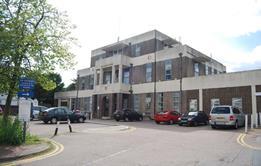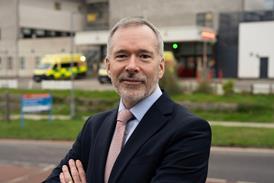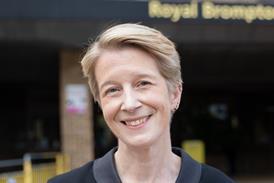HSJ first learned of David Fuller’s crimes in June this year, but agreed to a request by Kent police not to publish before his trial concluded. We can now reveal all that we discovered.
To many of his colleagues at Tunbridge Wells Hospital, David Fuller was an affable and helpful maintenance supervisor who was always willing to carry out small tasks and was the “go to” man if a problem needed sorting. His arrest on murder charges last December was greeted with shock and disbelief by those who knew him.
Today, hospital staff are dealing with the realisation that this façade was a cunning ploy, used as a way to get access to bodies in the hospital’s mortuary and carry out his attacks.
As a maintenance supervisor, Mr Fuller was able to access the mortuary at any time, including after the staff finished work at 4pm. His working hours were frequently 11am to 7pm, allowing him plenty of time to access the mortuary when no one else was there.
CCTV images taken from the main part of the mortuary show him entering carrying workman’s tools or with a clipboard, doing routine tasks such as checking fridge temperatures. However, once he entered the post-mortem room, there were no CCTV cameras and no one to see what he was doing.
Over 12 years — first at the Kent and Sussex Hospital and then at the newly-built Tunbridge Wells Hospital — he sexually violated the bodies of 100 women without any of his colleagues suspecting anything amiss. In some cases, bodies were repeatedly assaulted — in one case, he returned over four days to assault one body. Some of the assaults involved penetration of the body — an offence under section 70 of the 2003 Sexual Offences Act.
Police do not believe he had any accomplices and they have no evidence any mortuary assaults happened before 2008. None of the assaults were at the Maidstone and Tunbridge Wells Trust’s other acute hospital in Maidstone.
Identifying the bodies
Identifying the bodies that were abused has involved piecing together evidence from mortuary records, studying physical features and tattoos visible on the body, and, in some cases, glimpses of name bands.
Mr Fuller had recorded the assaults on a small digital camera with the videos and photographs later being transferred to his home computer or external storage devices.
When police searched his house in Heathfield, East Sussex, after his arrest for the 1987 murders, they found 14m images and 4m videos in his home office and loft which have taken months to sort through. There were 100 hard drives, 2,200 floppy discs, 30 sim cards and mobile phones, 1,300 CD and DVDs, and 34,000 photographic prints, slides, negatives and film rolls.
Mr Fuller had labelled some of the hard drives with names of some victims and had also kept a notebook in which he recorded their names. Some of the images which police discovered also revealed the time and date they were taken which helped to narrow down the possible victims.
Police had access to 150,000 hours of CCTV footage from the Tunbridge Wells Hospital from May 2020 onwards and swipe card data from the winter of 2019 until he was arrested which allowed them to track Mr Fuller’s movements around the hospital and mortuary. This narrowed down the time when he could have entered the post-mortem room to commit the crimes.
The evidence on identification was presented to detective chief superintendent Paul Fotheringham, who led the inquiry for Kent police. He took the decision in each case on whether there was sufficient evidence to identify each woman and then, if so, to inform families.
But despite all this work, police believe some bodies will never be identified because, for example, there are just a few still images of them which reveal no other identifying marks to aid identification. At any one time, there are 20 to 25 women’s bodies stored in the mortuary.
Who knew what when
Mr Fuller was originally employed by former Tunbridge Wells Health Authority in 1989 but his job was transferred to private finance initiative developer, Interserve, in 2011. Interserve has been contacted for comment but had not responded at time of publication.
Mr Fuller was sacked by Mitie — which took over the facilities management side of Interserve just days before his arrest — when he was charged with murder.
After Mr Fuller’s arrest and the discovery of the mortuary images and videos, police visited MTW’s chief executive Miles Scott to tell him about the offences. Since then, the mortuary assaults have been a closely guarded secret.
Within the NHS, only a small number of MTW staff, the regional director Anne Eden and selected people at NHS England – including chief executive Amanda Pritchard — were aware of the gravity of the case. At government level, the health and justice secretaries have been kept informed, along with their senior staff and advisers. Of the 100 police officers working on the murder case, only around a third were aware of the parallel investigation into the hospital offences.
On learning of Mr Fuller’s offences, the trust comissioned an independent inquiry and took some immediate steps to improve the security of its mortuary.
The consequence for the regulation of NHS mortuaries
HSJ reported earlier this week that NHS England had told trusts to examine some aspects of their mortuary security. But this may be just the start of further action to prevent such a case happening again.
The Human Tissue Authority licenses establishments which remove, store or use human tissues for various purposes, including post-mortems. This means most larger hospital mortuaries are licensed and inspected by the HTA.
Its regulatory powers do not currently extend to other mortuaries without post-mortem facilities, either in hospitals or those run by local authorities. Many bodies are also held by funeral directors, where there is no such regulation.
The HTA’s mortuary inspections look at areas such as governance, traceability and premises, as well as at facilities and equipment.
Mr Fuller was able to access the post-mortem room at Tunbridge Wells where there was no CCTV coverage and carry out his crimes there.
The HTA’s licensing standards stress the importance of controlled access to the body storage areas and the post-mortem room, and say security arrangements should “ensure oversight of visitors and contractors who have a legitimate right of access”. Mr Fuller had not been a trust employee since 2011 but his role in maintaining and checking equipment meant he had easy access to the mortuary, including at times when he would be there alone.
An HSJ investigation in 2018 found a large number of failings in mortuaries inspected by the HTA, although these tended to be around premises and the environment rather than issues of security or access.
How relatives and staff will be supported
Both the families of the women violated by Mr Fuller and some staff at Maidstone and Tunbridge Wells are expected to need psychological help to deal with the enormity and nature of Fuller’s crimes.
Police family liaison officers were in contact with the known close family members of the women before the murder trial.
The operation involves more than 150 specialist family liaison officers who will aim to contact the family members simultaneously. Most of the women were from Kent or East Sussex (both hospitals involved are close to the borders of the two counties) but their immediate family members were from a wider area.
Families will be offered a range of support, including psychiatric counselling, and will also be given a letter from Mr Scott, with a personal apology and containing an invitation for them to contact the trust if they want to.
What level of detail the families will want is expected to vary considerably, although HSJ understands some are extremely distressed and angry.
The victim’s commissioner has given advice on how to handle this very delicate case and the police have been advised by an ethics committee. Because the case is unique, the package of support has had to be developed specifically for the circumstances. It is expected to cost around £1.5m with funding coming from the Home Office, Ministry of Justice and Department of Health and Social Care.
Although the police have known the identities of some victims since the spring, they have waited for the package to be developed before contacting any of them.
A team of senior clinicians from the trust has also been on hand to provide a point of contact for any questions from the families about their loved one’s medical history. They will also guide the families through decisions about what they want to know. The clinicians were recruited and prepared for the role over the last few months without being told the detail of the offence.
If families want to know more details about the assaults, those will come from the police. Police are also expecting to hear from families who fear their female relatives who passed through the mortuary could have been one of the unidentified victims. In many of these cases, they should be able to offer reassurance that they were not.
The core group at the trust who have been involved in the Fuller case have access to dedicated counsellors from the local mental health trust and in house psychological support: now the crimes are becoming known, this will be extended to other staff.
Statement from the trust’s chief executive
Mr Scott said: “I want to say on behalf of the trust how shocked and appalled I am by the criminal activity by David Fuller in our hospital mortuary that has been revealed in court this week.
“And most importantly, I want to apologise to the families of those who have been the victims of these terrible crimes.
“We’ve been working with a team of specialist police family liaison officers to offer these families whatever help or assistance they may need.
“I am confident that our mortuary today is safe and secure. But I am determined to see if there are any lessons to be learned or systems to be improved.
“Sir Jonathan Michael — a fellow of the Royal College of Physicians — has been commissioned to independently chair an investigation into how this could have happened and to identify anything we could or should have done to avoid it. Sir Jonathan has begun work on his investigation and once completed I’ll be able to say more.
“I will ensure that staff at our hospitals are supported as they also process this shocking news. Our mortuary team have been particularly distressed to learn about what has been revealed over the course of this trial.
“My immediate priority though is to ensure the families of Fuller’s victims are given the time, space and privacy to come to terms with what they’ve learned — and that they receive all the care and support they need.”
Timeline
1987 – David Fuller murders two women — Wendy Knell and Caroline Pierce — in Tunbridge Wells.
1989 – Mr Fuller starts working as an electrician at the Kent and Sussex Hospital in Tunbridge Wells, then run by the Tunbridge Wells Health Authority.
2008 – First evidence Mr Fuller was violating bodies in the hospital mortuary.
2011 – With the opening of the new Tunbridge Wells Hospital, Mr Fuller is transferred to facilities provider Interserve.
2012 – Police reveal they have a full DNA profile for the man suspected of murdering both women, but do not know who he is.
2015 – Mr Fuller has a Disclosure and Barring Scheme check which reveals convictions for burglaries in the 1970s.
2020 – In December, Mr Fuller is arrested and charged with both murders. Police searching his house and computer find evidence of the mortuary crimes and contact Miles Scott, Maidstone and Tunbridge Wells Trust chief executive.
2021 – In a January court hearing, Mr Fuller pleads not guilty to the murders. He is later charged with additional offences, including the mortuary ones. The trust sets up an inquiry, chaired by Sir Jonathan Michael.
October 2021 – Mr Fuller pleads guilty to mortuary offences.
4 November 2021 – Part way through a trial, Mr Fuller changes his plea to guilty of the murders. He had previously admitted killing Ms Knell and Ms Pierce but denied murder on the grounds of diminished responsibility.
How big is the problem?
Police have described Mr Fuller’s crimes as “unprecedented” but inevitably they raise the question of how common sexual assaults on dead bodies are, where they occur, and what can be done to prevent them.
Penetration of a dead body for sexual purposes with any body part or object was only made a specific offence in 2003 under section 70 of the Sexual Offences Act. The maximum sentence for it is two years, which ministers may feel is out of kilter with the public outrage and disgust such offences generate.
However, offences under section 70 seem very rare. A Freedom of Information Act response from the Ministry of Justice suggested there had been no convictions from 2012-13 to 2016-17.
In 2018, a Birmingham man pleaded guilty to a s70 offence of violating a corpse after breaking into an undertaker’s. He was later sentenced to six years in prison for the s70 offence and burglary.
Assaults on bodies while they are on NHS premises are rarer still. The investigations into Sir Jimmy Savile’s abuse at Leeds General Infirmary heard he claimed to have interfered with the bodies of dead patients, including performing sex acts on them. The entertainer — who died in 2011 — had been a volunteer porter at the hospital for many years and was alleged to have abused 60 patients and staff.
Sue Proctor, who led the inquiry into his actions at the Leeds hospital, said controls on access to the mortuary were “lax”. The investigation concluded “it is evident his interest in the mortuary was not within accepted boundaries”. By the time the report came out, however, access to the mortuaries at the trust’s hospitals had been changed with keypad and passcode access only available to authorised people.
100 corpses sexually abused in two NHS mortuaries over 12 year period

A man who murdered two women 34 years ago went on to sexually abuse 100 female corpses in hospital mortuaries, taking videos and images of his crimes, HSJ can reveal.
- 1
- 2
 Currently
reading
Currently
reading
Exclusive: The full story of David Fuller’s mortuary attacks
































11 Readers' comments